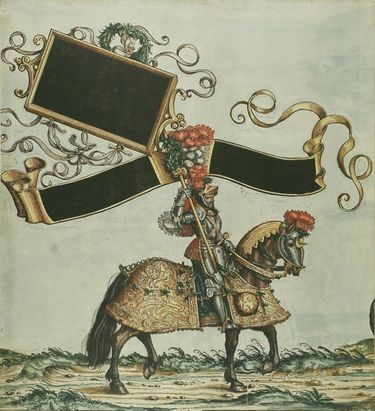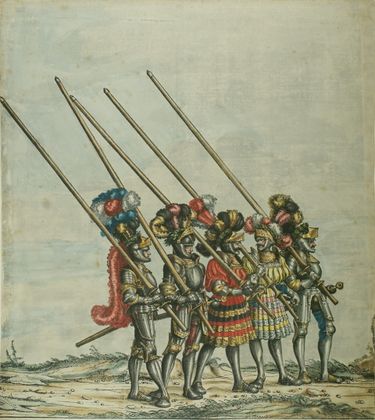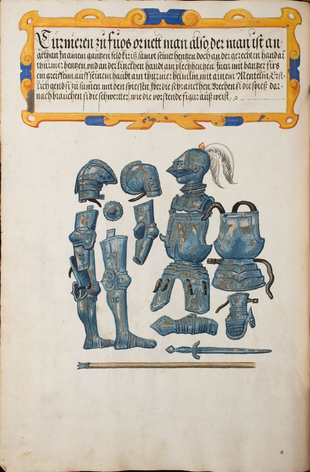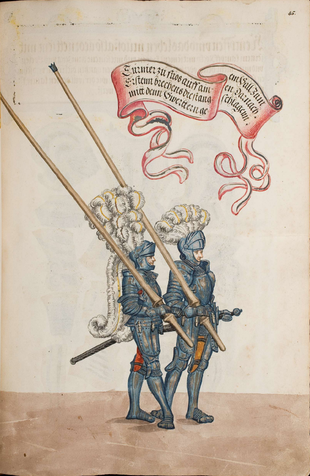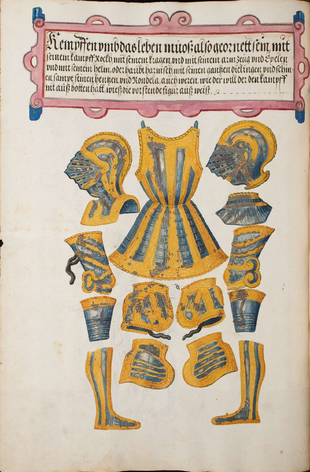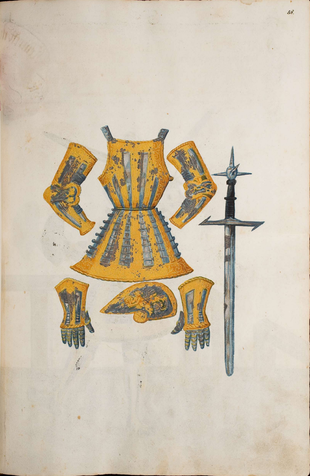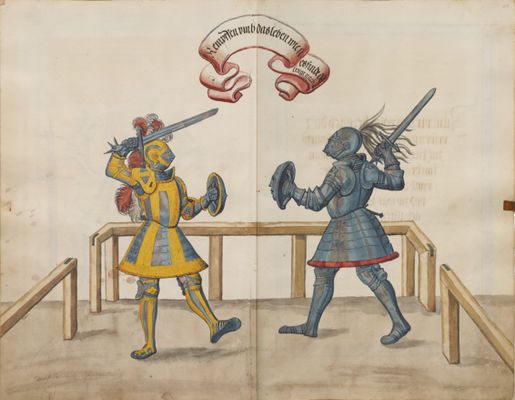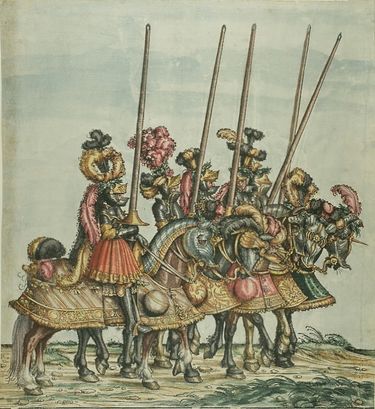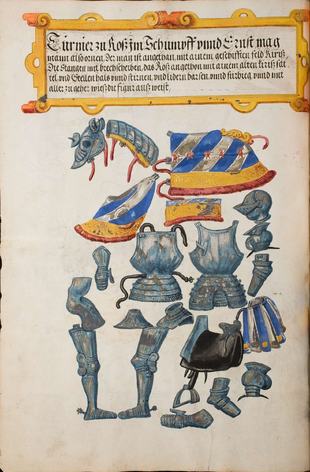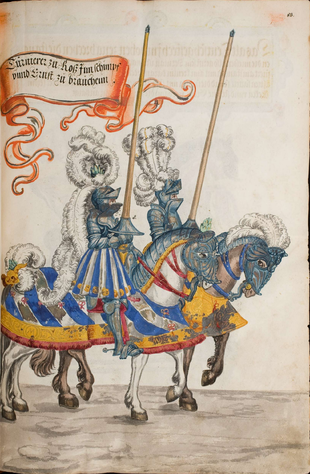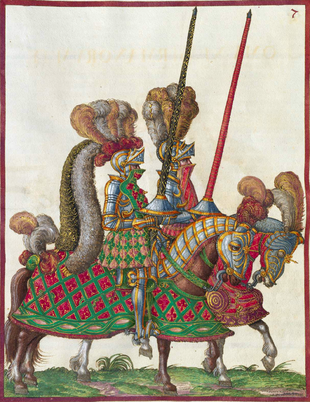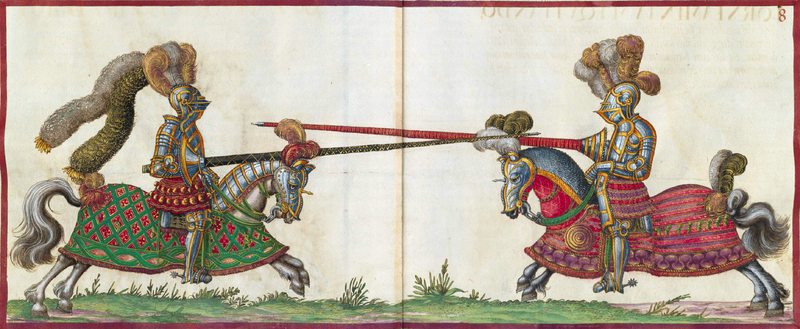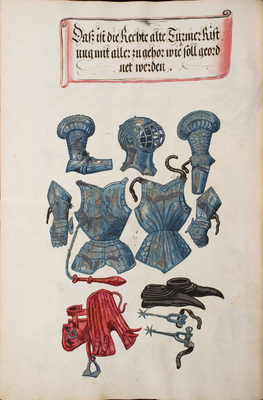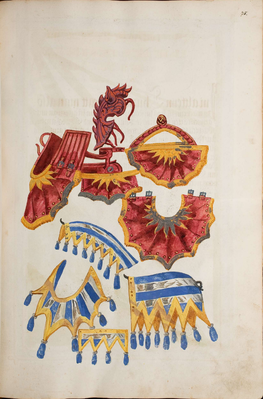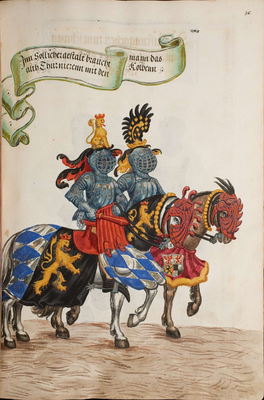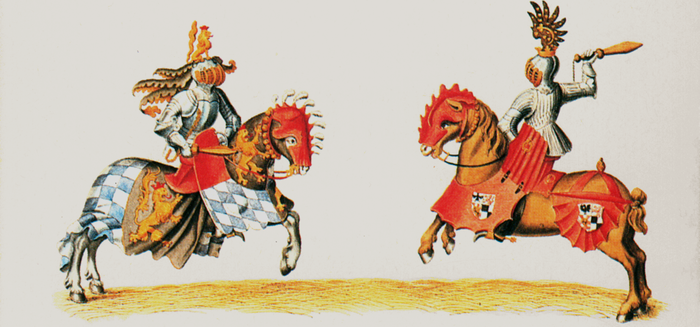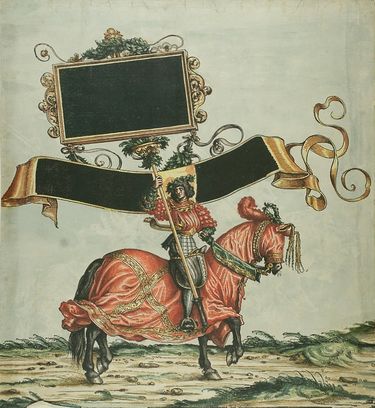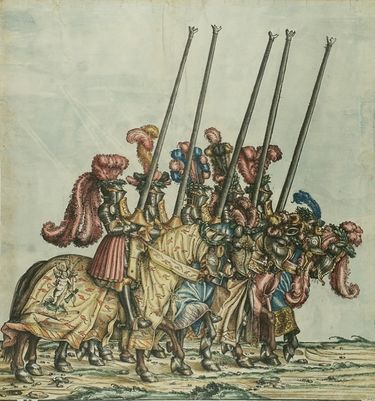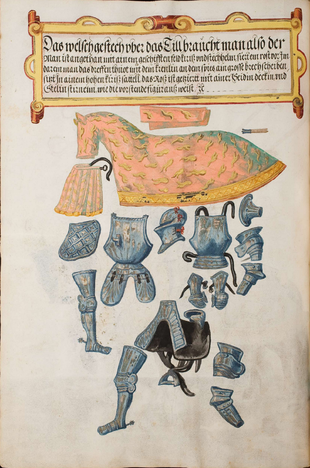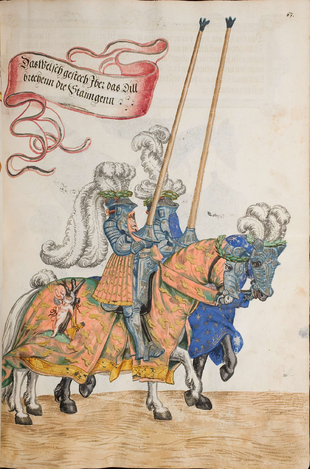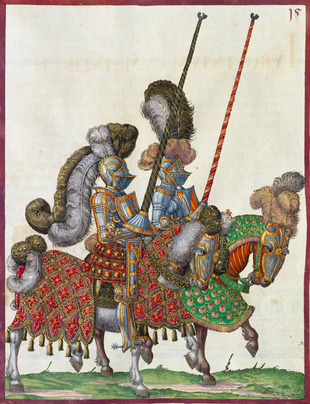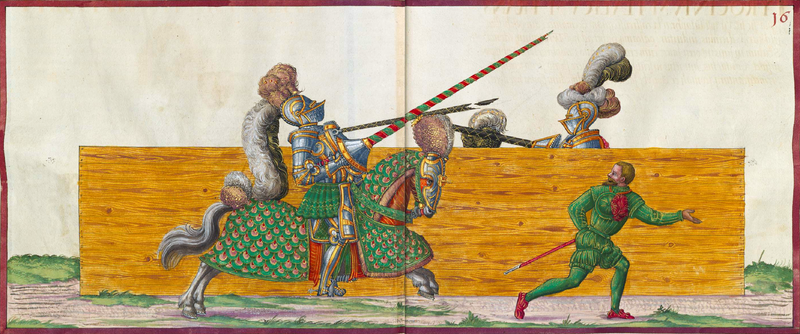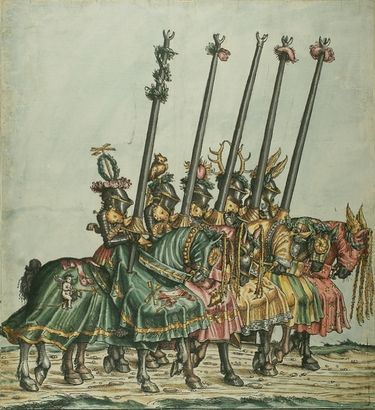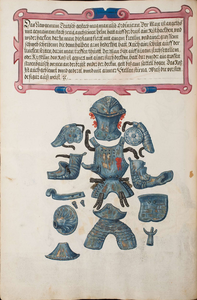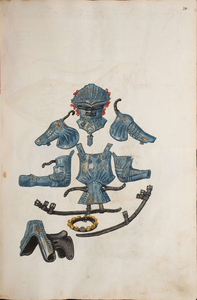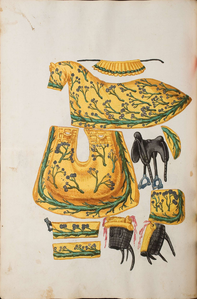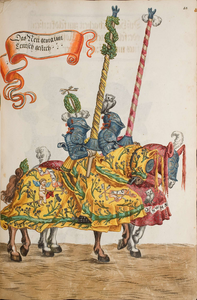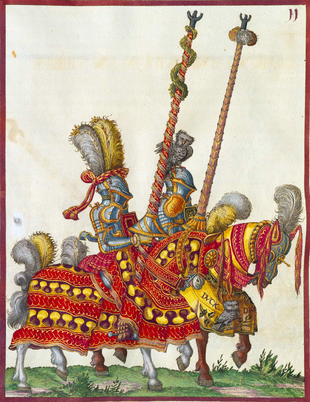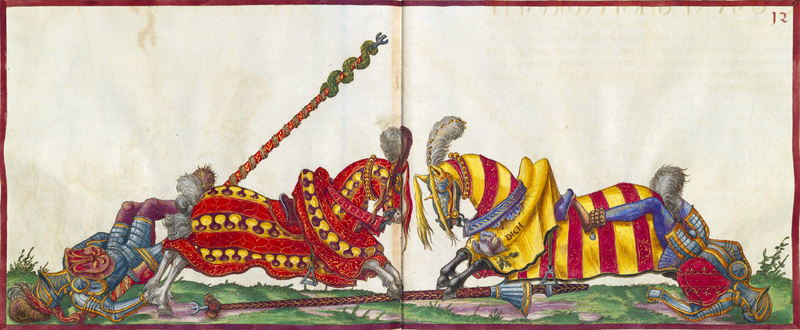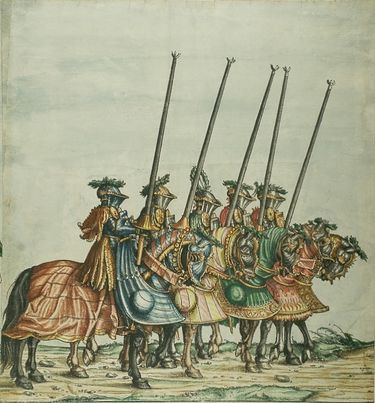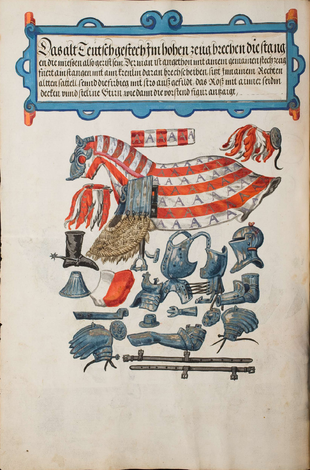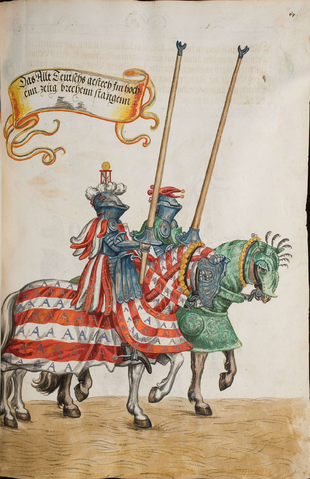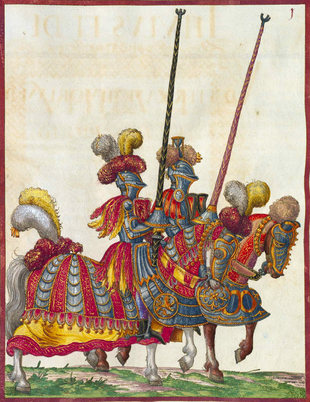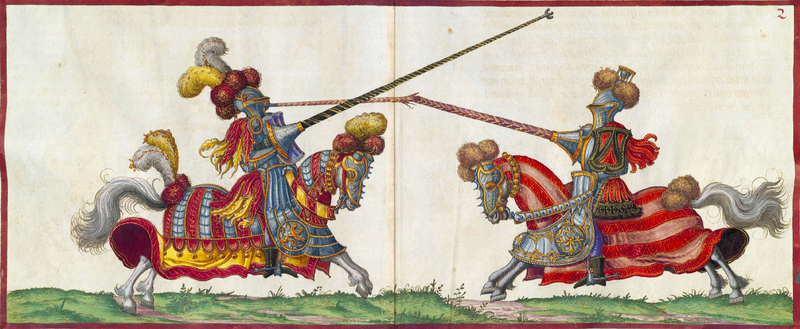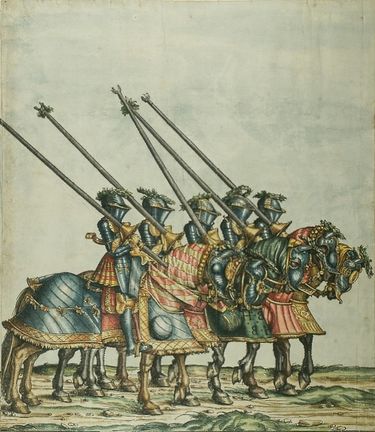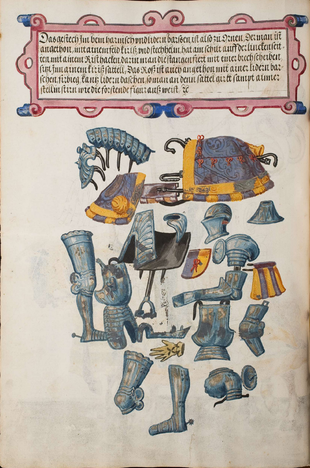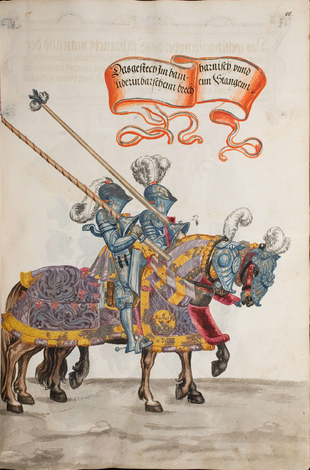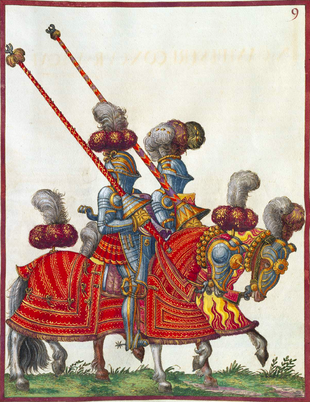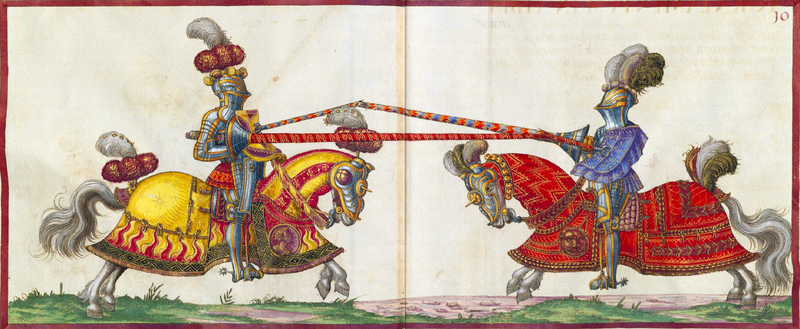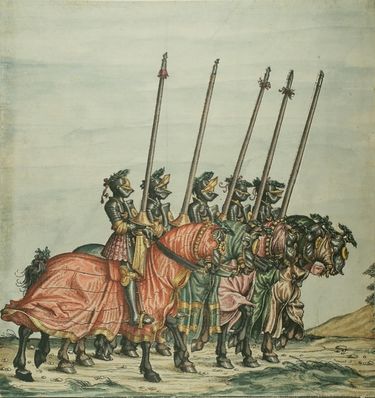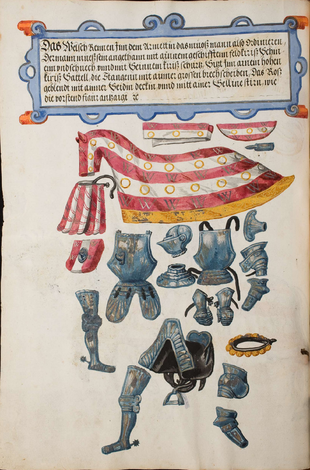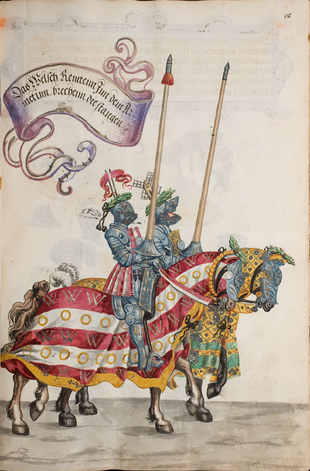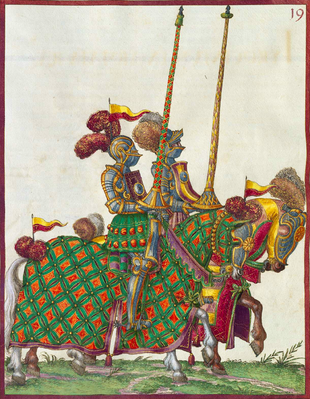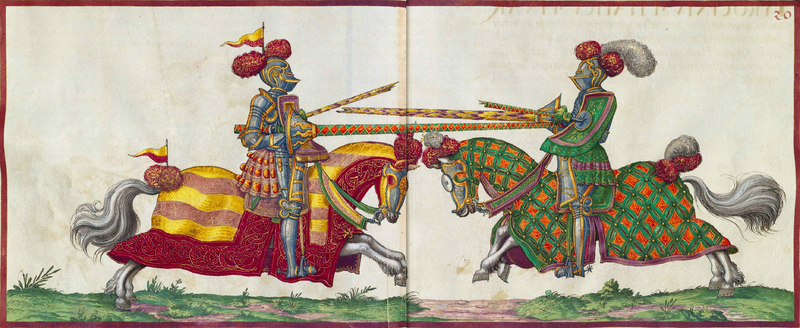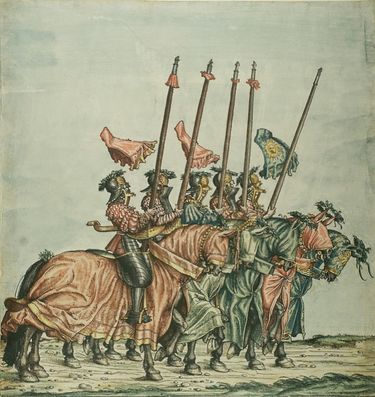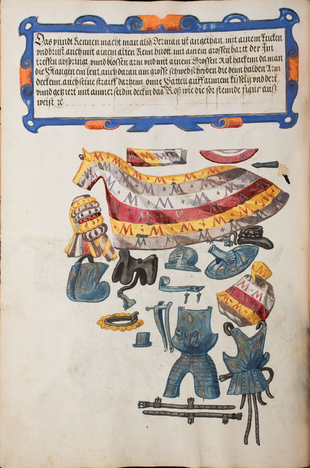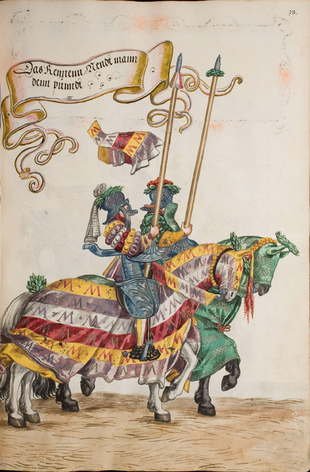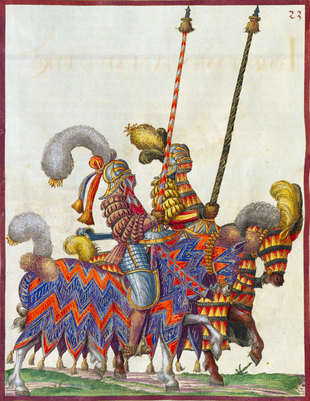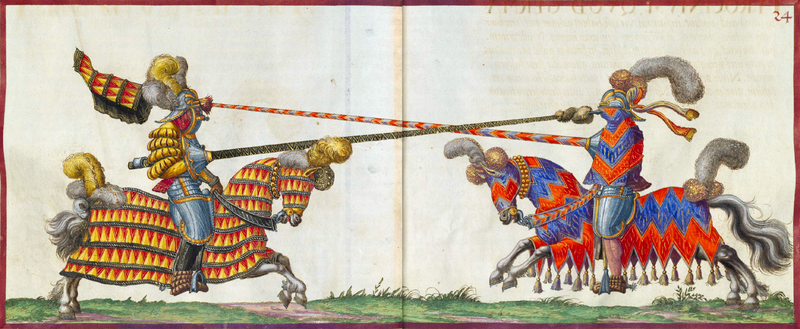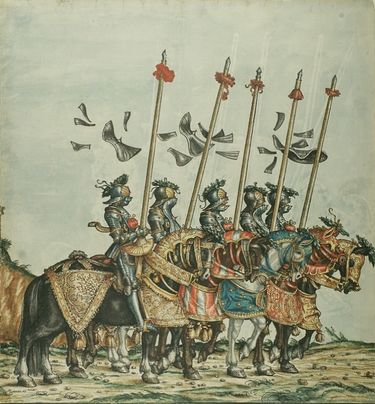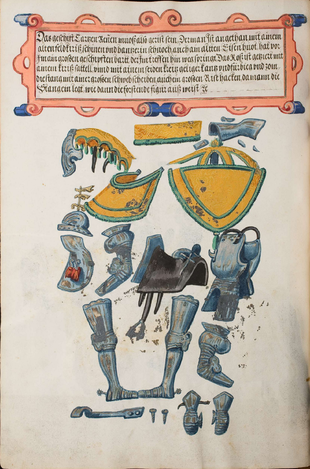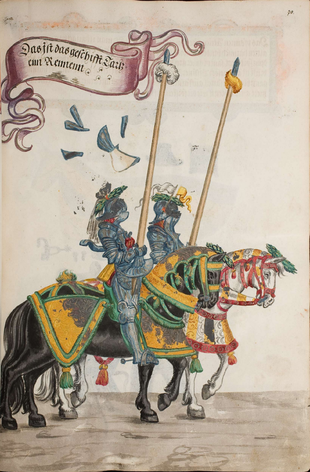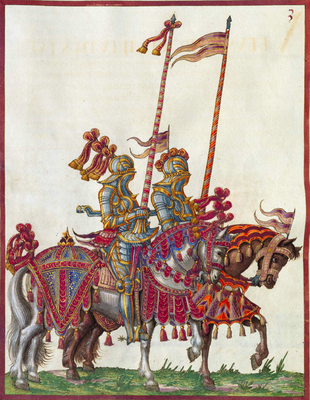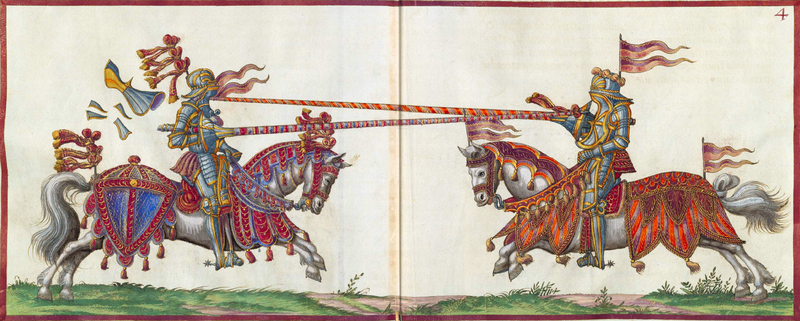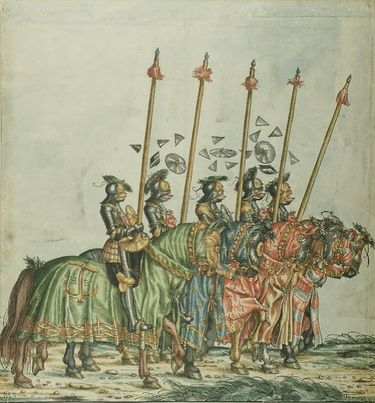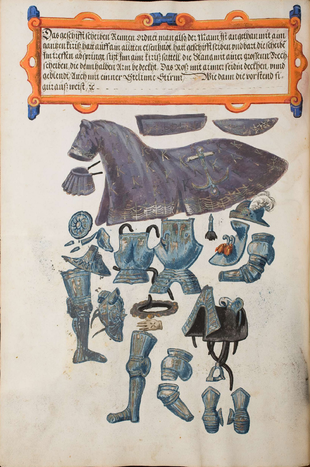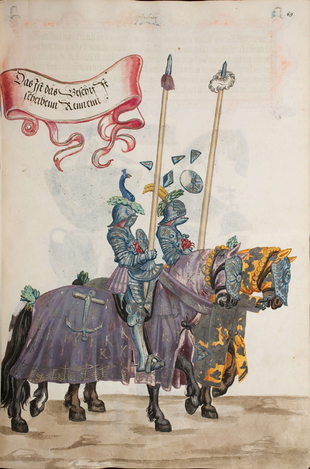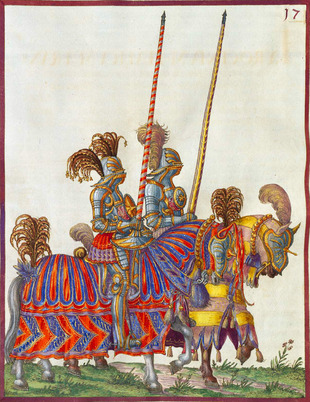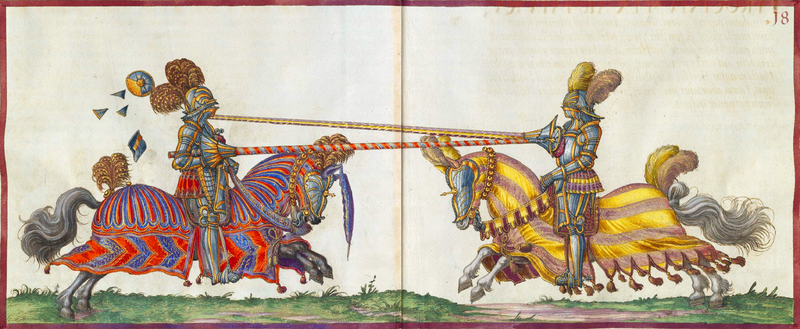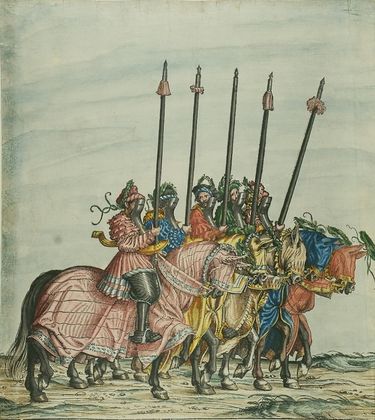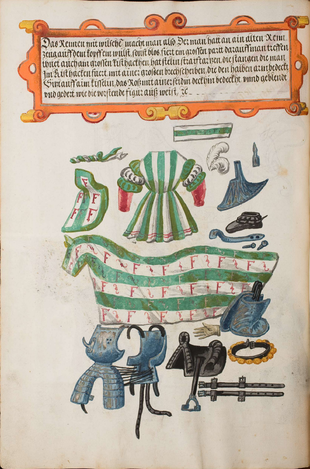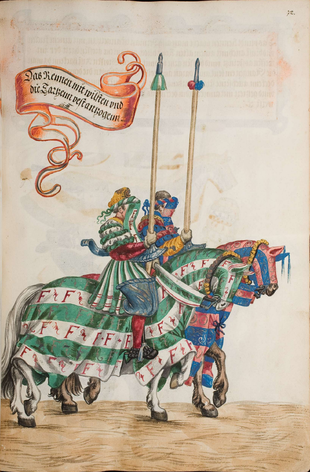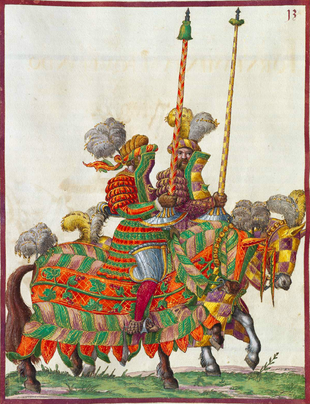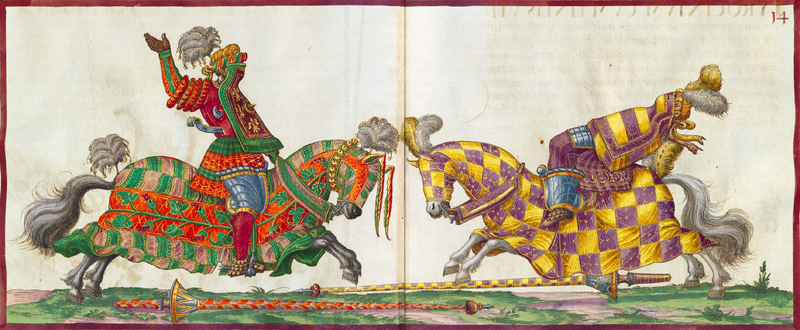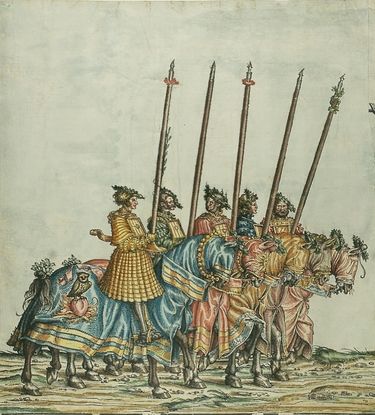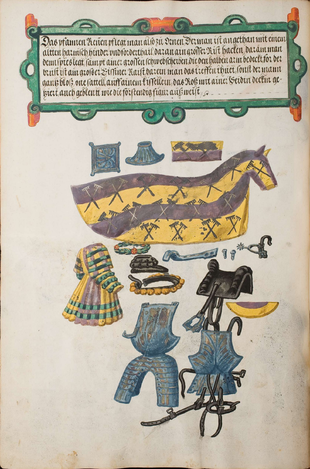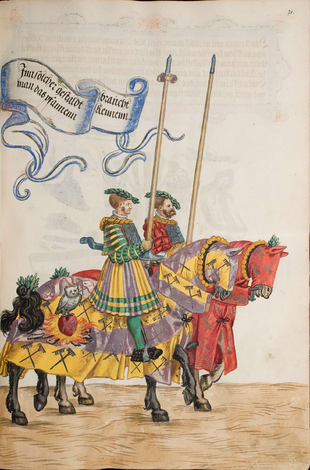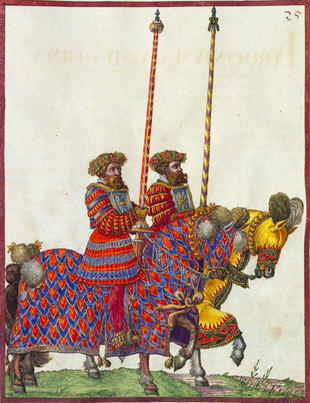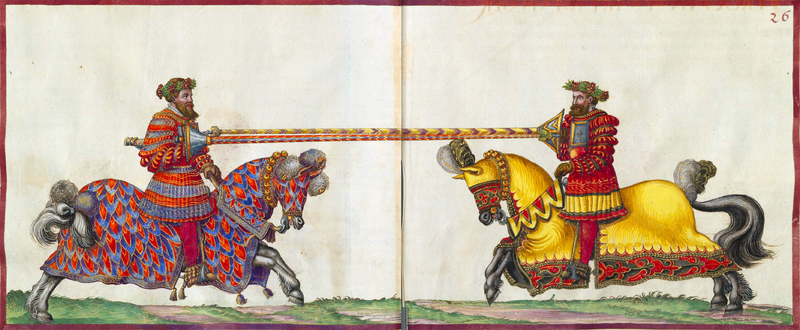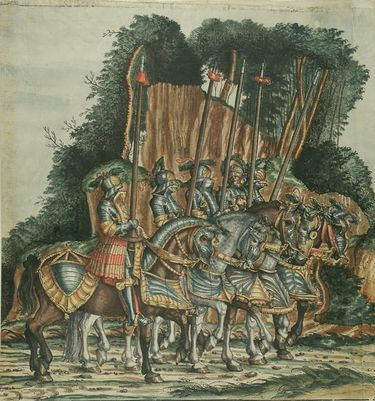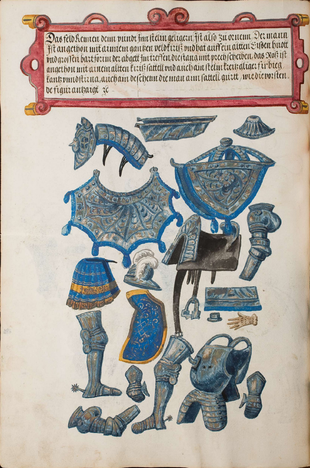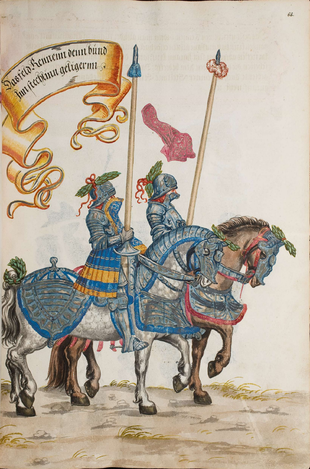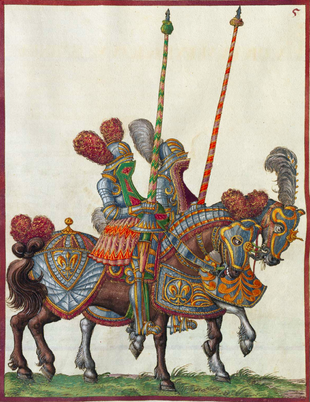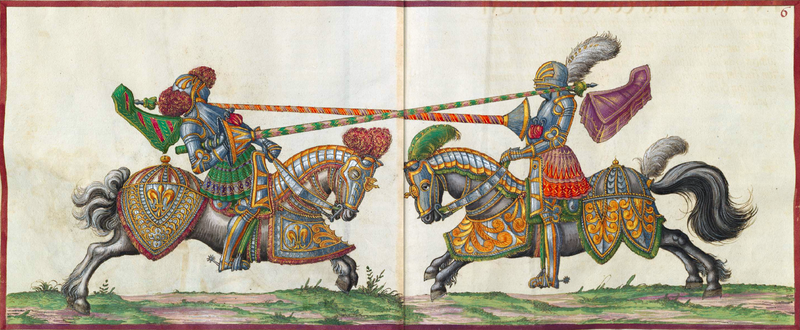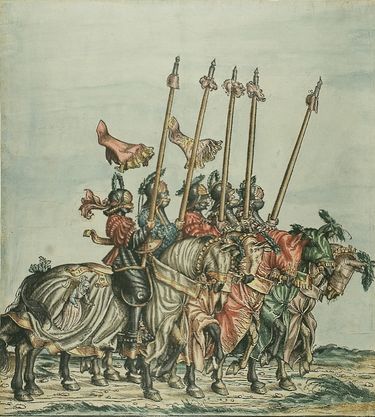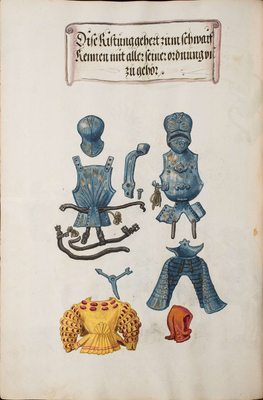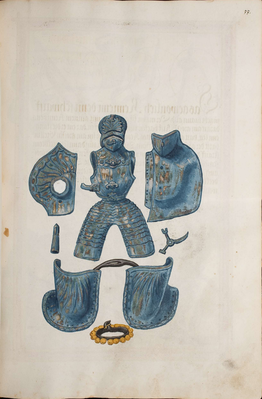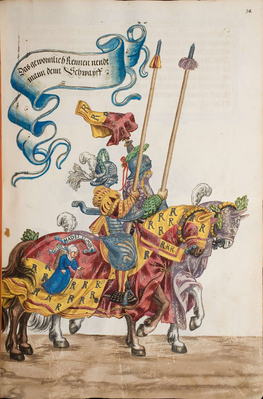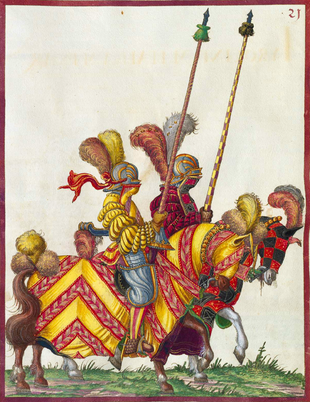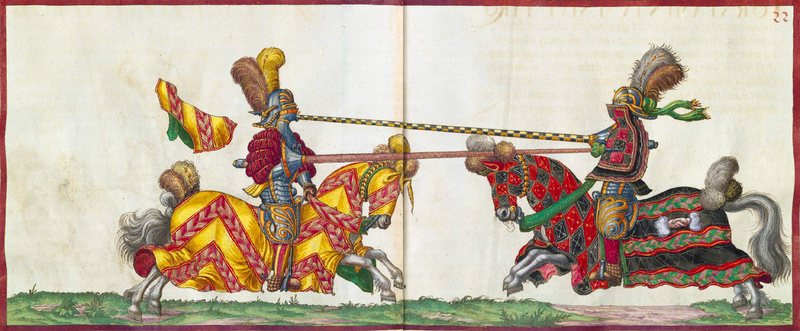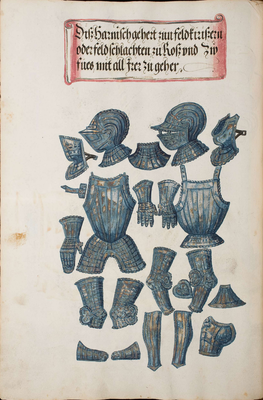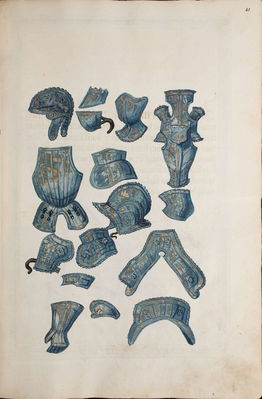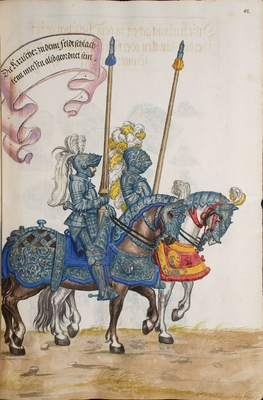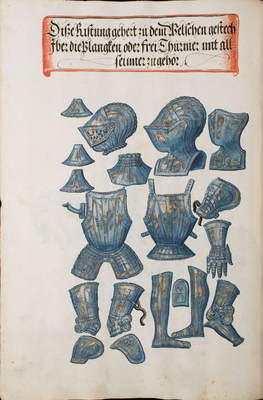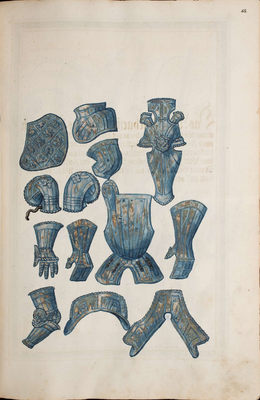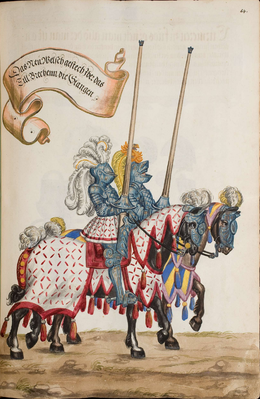|
|
You are not currently logged in. Are you accessing the unsecure (http) portal? Click here to switch to the secure portal. |
Burgkmair Turnierbuch
Contents
Tournaments
Images |
Images |
Burgkmair Tournierbuch (ca. 1520s) |
Munich Transcription (1540s) |
Vienna Transcription (ca. 1600) |
Wolfenbüttel I Transcription (ca. 1600) |
New York Transcription (1838) | |||||
|---|---|---|---|---|---|---|---|---|---|---|---|
The various old and new noble and knightly German forms and Disciplines of jousting or ”tilt”, as they call it nowadays. |
Ettliche weilend des Aller durchleuchtig isten hochmechttigisten Fürsten und herren herrn Maximilionn Römischenn Keyserß &c hochloblichister gedächnus Ritterspile zum tail durch fr maiestätt selbß erfunden anngeben unnd sonnst mitt anndern zu lust und kurtz weill gebrãucht werdenn. |
[095r] Veterum Germanorum, et novissimorum principum etiam Tyrociniorum, vel ut hodie vocant, certaminum equestrium alioquot species, et formae. |
|||||||||
Title and dedication To the eternal memory of the late Roman Emperor Maximilian, I have here gathered these jousting or tilt games, and put them in order. The late emperor Maximilian himself devoted himself and exercized himself in them, and he even invented many of them as well. Therefore lest this honourable and sportly exercise of the nobility would to perish, I have here given them to posterity, especially for the eternal praise to those who still devote themselves and love it, which can be understood here, how to do that they have before their eyes, so that they be able to reconstruct each and everyone of them. |
[095v] Titulus, et dedicatio. Ad aeternam memoriam divi Maximiliani Romanorum Imperatoris, Caesaris, et Augusti, has Tyrociniorum seu ut nunc vocant Certaminum equesterum[!] species collegi, atque ex ordine locavi. His enim ipse D. Maximilianus studuit, easque exercuit, plerasque etiam invenit primus. Quare ne huiusmodi nobilitatis honesta, ludicraque exercitia pereant, ea immortalitati donavi: presertim ad aeternam laudem nobilitatis, et eorum omnium, quibus huiusmodi ludi adhuc cordi sunt, ut scilicet hinc, quid sequi debeant ad oculum habeant, et sibi singula ad imitationem proponere possint. |
||||||||||
In the third part follows hereby explained how the man and horse is to be equipped in all kinds of jousting of peace and of war and on the battle field, for sport and in ernest, with all equipment and armour, all parts, such as caparisons, saddles, chanfrons, peytrals, barding and weapons, what they may be called, and how they are put on. |
[057v] Zum Dritten volgt hernach wie Roß unnd Mann, zu allen gestechen, Rennenn, Thurmeren, zum krieg Inn Feldschlachten, zu schimpff und Ernst, geordnet, auch mit aller Irer zu gehör, unnd Ristungenn, alle stuckh, als Deckinen, Settel, Parscha, gliger, harnisch, unnd wie sie genendt megenn sein Erglegt, ab unnd widerunt angethon sollenn werdenn, &c |
[061v] Zum Dritten volgt hernach wie Roß und Mann, zu allen gestechen, Rennenn, Thurmeren, zum krieg Inn Feldschlachten, zu schimpff und Ernst, geordnet, auch mit aller irer zu gehör, und Ristungen, alle stuckh, als Deckinen, sätel, Parscha gliger, harnisch, und werr, wie sie genandt mögen sein Erglegt, ab unnd widerum angethonn sollen werdenn &c |
|||||||||
Herr Antony von Iffon, always torney master. |
Imperator Caeser Maximiliani Augusti praeexercitamenta militaria. Bei Raÿ Zhai': zeittenn ist herr Antonni vonn Iffonn oberster durniermaister Beweßen. Er hat das Ehrlich Ritterspill, |
[058r] Herr Anthani von ÿffon Alwegen Turniermaister |
[062r] Herr Anthani, von Iffon Alwegen Turniermaister |
||||||||
Dise manier braucht man zum durnier, zu fuoß Iber die schranncken mit spieß prechenn, darnach mit den schwertter ainn annder zw schlagenn. |
|||||||||||
Torney on foot in a hall(?). First to break the lances, and then they hit each other with the swords. Foot tourney is arranged thus: the man is equipped with a full field armour but on his right hand he wears a torney gauntlet, and on his left a plate gauntlet with plate for gripping, on his head a torney helmet with a small mantle. First they attack each other with the lances over the fence. If they break the lances, then thereafter they use their swords, as is shown in the following picture. |
[080v] Turnieren zu Fuoß ornett man also, der Man ist angethann, Inn ainem gantzen Feld kirisch sampt seinner hentzen, Doch an der gerechten hand ain Thurnier hentzen, unnd an der lincken handt ain plech hentzen, Innen mitt bantzer firs ein greiffen, auff seinem haupt ain Thurnier Helmlin mit ainem Mentelin, Erstlich gennd sÿ zu samen, mit den spiessen yber die schranncken, Brechen si die spieß, darnach brauchenn si die Schwertter, wie die vorstende figur auß weissen. [081r] Thurnier zu fuos auff ainem Sall, zum Ersten brechens die stangen, darnach mit den schwertern geschlagen. |
[084v] Turnieren zu fuos ornett man also, der man ist angethan In ainem gantzen feld kiriß, sampt seiner hentzen doch an der gerechten hand ain thurnier hentzen, und an der linckhen handt ain plech hentzen, Inen mit bantzer firs ein greiffenn, auff seinem haubt ain thurnier helmlin, mit ainem Mentelin, Erstlich gend si zu sammen mit den spiessen, Iber die schranckhen, Brechen si die spieß darnach brauchen si die schwertter, wie die vorstende figur auß weist. [085r] Turnier zu fuos auff ainem Sall, zum Erstenn brechens die stangen, Darnach. mitt denn Swerttern geschlagenn. |
|||||||||
Fighting on life and death must be done as follows with a surcoat, arm armour and pauldrons, and helmet or head armour, with full cuisses and greaves, as well as gauntlets and besagews, and also whatever weapons for anyone who wishes not to lose the fight, as can be seen in this following picture. |
[081v] Kempffen umb das leben mueß also geornet sein, mit seinem kampff Rockh, mit seinem kragen, unnd mit seinem arm Zeug und Exelen, und mitt seinem Helm, oder haupt harnisch, mit seinen gantzen dielingen und schinen, sampt seinenn hentzen unnd Rondela, auch weren, wie der will der den kampff mit auß potten hatt, wieß die vorstende figur auß weist. |
[085v] Kempffen umb das leben muoß also geornett sein, mit seinem kampff Rockh, mit seinem kragen, und mit seinem arm zeug und Evelen[!] und mit seinem helm, oder haubt harnisch, mit seinen gantzen dielingen und schinen, sampt seinen hentzen, und Rondela, auch weren, wie der will der den kampff mit auß botten hatt, wieß die vorstende figur auß weist. |
|||||||||
Here they fight on life and death. |
[082v3r] Kempffen umb das leben, wie si esfinde de lenge nach |
[086v7r] Wie Kempfft ma[…] umb Leib und leben. |
|||||||||
Dises ist ainn feld durnier, oder auff ainnem platz, das si die stanngenn brechen darnach mit denn schwerttern ain annder zu schlagen. |
|||||||||||
Jousting either in ernest or for sport, is performed thus: the rider wears an armour that in German is called "den geschifften küriss". The lance has a vamplate. The horse is equipped with a caparison made out of leather. The mane and neck of the horse is covered in steel armour, as well as the chanfron, as the picture clearly shows. |
Tourney on horse, both for sport and in ernest is arranged thus: the man is wearing an articulated field armour, the lance has a vamplate, and the horse is wearing an old armour saddle, steel criniere, and leather peytral and croupiere, steel chanfron, and all equipment as is shown in this picture. How to tourney on horse for sport and in ernest. |
[107v] Torneamentum equitando, serio, vel ioculariter, sic instituitur. Vir ipse Cataphracta induitur, quam Germani (·den geschifften küriss·) vocant. Hasta habeat Trochleam frangibilem. Equus vero Barsona ex corio facta tegatur. Iuba, sive collum equi armatura ex Chalybe muniatur: unde et frontale fieri debet. Sicuti haec figura clare indicat. |
[058v] Turnier zu Roß Im schimpff und Ernst, mag man also ornenn, Der man ist an gethan mit ainem geschifften feld kiriß, die stangen mit brechscheiben, das Roß angethon mit ainem alten kiriß sattel und Stellen hals und stirnen, und lidern barsenn, unnd furbieg, unnd mit aller zu geher, wieß die figur auß weist, &c [059r] Turnier zu Roß In schimpf und Ernst, zu brauchenn. |
[062v] Turnier zu Roß Im schimpff unnd Ernst, mag mann also ornen, Der man ist angethan, mit ainem geschifften feld Kiriß, Die Stangen mit brechscheiben, das Roß angethon mit ainem alten kiriß sattel, und Stellen hals unnd stirnen, und lidern barsen, unnd furbieg, unnd mit aller zu geher wieß die figur auß weist, [063r] Turnierer zu, Roß Inn schimpf unnd Ernst, zu brauchenn. |
|||||||
[7] In this manner the jousters enter the arena.[1] |
[106r] Hoc modo in harenam descendunt equites pugnaturi. |
||||||||||
[8] Here they engage each other, either for sport or in ernest. |
[106v07r] Ad hunc modum deinde invicem petunt equites, serio aut ioculariter. |
||||||||||
|
|
This is the right old tournament armour, with all parts and how they are arranged. Old torney on horse for sport is usually done in this manner: the man is equipped with an old field armour, without leg armour and sabatons, only a pair of boots with soft bootlegs, old shoulders and old arm harness. On the head an old tournament helmet and in with his old tournament gauntlets. On the chest there is a chain that a battle club is hanging from. The man is sitting on an old tournament saddle, and the horse is adorned with an old steel crupier, peytral and flanchards, that are attached to the saddle, as well as old steel peytral and chanfron as the following pictur shows. |
[071r] Daß Ist die Rechte alte Turnier Ristung, mit aller zu gehör wie sie soll geordnet werden. [071v] Im alttenn Thurnier pflegt man also zu machen zu Roß Im schimpff der man Ist angethon mit ainnem alten feld harnisch one schine unnd schuoch, nur zwen wachtel stiffell, sampt altten erelen und Unnd altten arm zeug, auff dem haupt ein alttenn Thurnier Helm unnd mit seinen altten Thurmier hentzen, an der brust ein Rettin, daran hengt der Kolb zum streitt, der man sitzt In aim altten Thurnier sattell, Das Roß getziert mit altten stelin gliger, firbieg unnd daschen, so mann an den Sattel girtt altten stelin kantz unnd stirnen wieß die forstende figur auß wisennt, &c |
[074v] Daß ist die Rechte alte Turnier Ristung, mit aller zu gehör wie si soll geordnet werden. [075v] Im alttenn Thurnier pflegt man also zu machenn zu Roß Im schimpff, Der mann Ist angethan mit ainnem Alten feld harnisch, Onne schine unnd schuoch, nur zwen Wachtel Stiffell, sampt altten Epelen unnd alttenn arm Zeug, Auff dem hauptt ein alttenn Thurnier hellm, unnd mit seinnenn alttenn Thurmier hentzhen, ann der Brust ein Rettin, daran hengt der Kolb zum streitt, Der Mann sitzt Inn aim altten Thurnier sattel, Das Roß getziertt mit ainnem altten stelin gliger, firbieg und daschenn, So mann ann den Sattell gurtt, Altter Stelin kantz unnd stirnenn wies die forstende figura auß weisenntt &c |
||||||||
In this manner is the old tourney with clubs done. |
[072r] Inn sollicher gestalt braucht man das alt Thurnieren mit den kolben. |
[076r] Inn Sollicher gestalt braucht mann das alth Thurnierenn mit den kolbenn. |
|||||||||
Jousting
Images |
Images |
Burgkmair Tournierbuch (ca. 1520s) |
Munich Transcription (1540s) |
Vienna Transcription (ca. 1600) |
Wolfenbüttel I Transcription (ca. 1600) |
New York Transcription (1838) | ||||||
|---|---|---|---|---|---|---|---|---|---|---|---|---|
Sir Wolffgang von Bolhaim, always a master of joust of war and piece. |
Beÿ Raÿ Zhaie: zeittenn ist herr Wolffganng vonn bolhaim Rennen und gestoch maister Beweßenn. Rennen und Stechen manichfalt, |
[070r] Herr Wolfgang von Bolhaim Alwegen Renn und gestech Maister. |
[074r] Herr Wolffgang von Bolhaim alwegenn Renn unnd Gestech Maister. |
|||||||||
Das welsch gestoch Iber das dill, wie mans gebraucht hatt Im, 1511, Jarr bei Kaißer Maximilions Seittenn. |
||||||||||||
Italian jousting over the tilt barrier is done thus: the rider is equipped with a field armour that we in German call "ain geschifften feldküriss". He wears a helmet suitable for this sort of jousting, and on his left side he carries a shield with a grill. He sits on a high knight's saddle. The hit, or strike is on the shield. The horse is covered with a silk caparison, and its forehead is protected by a steel chanfron, as the picture shows. |
Foreign gestech over the tilt is performed thus: the man is equipped with an articulated field armour, and a Stech helmet, they carry a grill to hit with the coronell. On the lance there is placed a large vamplate, he sits on a high armour saddle, and the horse is wearing a silk caparison and a steel chanfron as is shown in this picture. Foreign Gestech over the tilt where you break the lances. |
[111v] Tyrocinium Italicum trans septa sic fit. Vir ipse Cataphracta castrensi, quam Germanice (·ain geschifften feldküriss·) dicimus, induitur: galeamque habet ad hoc Tyrocinium indoneam. Scutum in sinistro gerit latere cum craticula. Alto Cataphractorum Ephippio insidet. Contactus, aut ictus inscutum fit. Equi vero strato serico tegantur premunianturque frontali ex Chalybe facto. Quemadmodum figura hac docet. |
[062v] Das Welsch gestech uber das Till braucht man also, der man Ist angethon mit ainem geschifften feld kiriß und stechhelm, fiert ain Rost vor Im darein man das treffen thuot mit dem krenlin an dem spies, ain grosse brech scheiben, sitzt In ainem hohen kiriß sattell, Das Roß ist getziertt mit ainer Seidin deckin, und Stelin stirnen, Wie die vorstende figur auß weist. [063r] Das Welsch gestech Iber das Dill Brechenn die Stanngenn. |
[066v] Das welsch gestech uber das Till braucht man also der Man ist angethan mit ainem geschifften feld kiriß und stechhelm, fiert ein rost vor Im darein man das dreffen thuot mit dem krenlin an dem spies, ain grosse brech scheiben sitzt In ainem hohen kiriß sattell, das Roß ist getziertt mit ainer Seidin deckin, und Stelin stirnenn, wie die vorstende figur auß weist, &c [067r] Das Welsch gestech Iber das Dill brechenn die Stangenn ·:· |
||||||||
[15] This way they enter the arena to compete over the tilt barrier. |
[110r] Hoc modo in harenam descendunt certaturi trans septa. |
|||||||||||
[16] This is the way jousting over the tilt barrier is done the Italian way. |
[110v11r] Sic fit Tyrocinium trans septa more Italico. |
|||||||||||
Das loblich gemain Teutsch gestech daß sy fallenn miesenn. |
||||||||||||
|
|
Common German jousting is done thus: the rider wears a common jousting armour, and in the lance he has coronells and a vamplate. He sits on a cushion, without saddle. The horse has covered eyes, as well as ears. The caparison is wholly made out of silk. Furthermore, the rider has large enough bundles of straw on the chest under the caparison, as is illustrated on the picture. |
The new common joust of peace is arranged thus: the man is equipped with a common joust of piece armour, as well as his helmet, on his chest he has an arret, and a lance rest in the back as well, wherein you insert the lance. The lance has a coronell, and a large vamplate covering half the man's arm. He has a shield also on his left side, where the lance is to hit. The man sits on a saddle for joust of peace or on a little cusion. The horse is adorned with a caparison for joust of peace, and under it a straw padded peytral that goes all the way to the saddlebow. The horse is also blindfolded and its ears muffled, and also has a steel chanfron, as is shown in the following picture. The new common German joust of peace. |
[105v] Comune germanorum tyrocinium sic fieri potest. Vir comuni armatura ad Tyrocinium idonea induitur, in hasta habeat corollas, cum trochleis frangibilibus. Ipse porrò pulvinari insideat, absque ephippio. Equo tegantur oculi, atq obturentur aures. Stratum omne ex serico fiat. Habeatque insuper ipse vir fasces stramineos satis magnos in pectore sub strato. Sicuti figura haec recte demonstrat. |
[074v] Das Neu gemain teutsch gestech mag man also ordinieren, der man ist angethan mit gemainem stech zeug, auch seinen Helm, hat auff der brust ain Rist hackhen, und wider hacken, darin man die stang fiert, mit einem krenlin, und ainer grossen schweb scheiben, die den halben arm bedeckht, hatt auch ain schiltt auff der lincken seitten darein man Treffen thuott, Der man sitzt auff ainem stech settelin, oder kissellin, das Roß ist getziert mit ainer stech deckhin, hatt dar under ain grossen stroen bausch, vornen an der brust, under der deckin, gett biß ann stattell bogen, Das Roß ist auch geblendt, unnd gedert, unnd mit ainer stellenn stirna, wieß die vorstende figur auß weist. [076r] Das new gemain Deutsch gestech. |
[078v] Das New gemain Teutsch gestech mag man also Ordinieren, Der Man ist angethon mit gemainem stech zeug, auch seinen helm, hatt auff der brust ain Rist hackhen, und wider hacken, dar In man die stang fiertt, mit ainem krenlin, und ainer grossenn schweb scheibenn die denn halben arm bedeckhtt hatt, Auch ain schiltt auff der lincken seitten, darin man treffen thuott, Der Man Sitzt auff ainem stech settellem, oder Rissellin, das Roß ist getziert mit ainer stech deckhin, hatt dar unnder ain grossen stroenbausch, vornen an der brust under der deckin, gett biß ann sattell bogen, Das Roß Ist auch geblennt unnd gedertt, unnd mit ainner Stellen stirna, Wieß die vorstende figur auß weist, &c [080r] Das Neu gemainn Teutsch gestech ·:· |
|||||||
[11] Thus they enter the arena, in common German jousting, or tilt. |
[104r] Sic in harenam descendunt, quantum ad comune Germanorum Tyrocinium & Torneamentum. |
|||||||||||
[12] Thus they run at each other in said common German jousting. |
[104v05r] Sic concurrunt in eodem Germanico comuni Tyrocinio. |
|||||||||||
Das gestech Inn hochen zeugenn fn verschlossen settlenn, brechenn die Stanngen. |
||||||||||||
Old jousting, or tilting as it is called today in old high armour (German: Im hohen zeug), where both break their lances, they enter the field (German: auf die pan), or the arena. The rider himself wears a common jousting armour, he has small rings[2] with a vamplate. He sits on an old high jousting saddle. The horse’s chest guard is stuffed with straw, and padded under the silk caparison. The chanfron is made out of steel, as can be seen in the picture here. |
The old German joust of peace in high armour, breaking the lances. They must(!) be equipped thus: the man is wearing a common armour for jousting of peace, he holds a lance with a coronell and thereon a vamplate. He is sitting on a straight old saddle, the (horse's) chest protection is filled with straw, and the horse is covered by a silk caparison and a steel chanfron, as is displayed on this picture. The old German gestech in high armour, when you break the lances. |
[097v] Vetus tyrocinij ludus est sive ut hodie vocant, ludicrum exercicium, in armatura alta (germanicè Im hohen Zeug·) ubi uterque hastam frangit, et ad hunc modum armati in harenam descendunt, aut ad stramentum (germanice ·auff die pan·) veniunt. Vir ipse induitur comuni Torneamenti armatura, corollas fert, cum Trochleis facile frangibilibus; Ipse porro insidet Ephippio ad Torneamentum vetus convenienti. Antilena equi stramine expletur, et suffarcinatur. Stratum equi ex serico fit, Frontale vero ex Chalybe. Sicuti haec figura presens omnia indicat. |
[059v] Das alt Teutsch gestech Im hohen zeug, brechen die stangen die meissen also gerist sein, Der man ist angethon, mit ainem gemainen stech zeug fuertt ain stangen mit aim krenlin, dar an brechscheiben, sitzt Inn ainem Rechten sattel eins alten, seind die firbieg mit stro auß gefildt, das Roß mit ainner seidin deckin, und steline Stirn wie dan die vorsteendt figur antzaigt, [060r] Das allt Deÿschs gestech Im hoch enn Zeug, brechen Stangenn. |
[063v] Das alt Teutsch gestech Im hohen zeug, brechen die stangen die meißen also gerist sein, Der man ist angethon mit ainem gemainen stech zeug fuert ain stangen mit aim krenlin dar an brechscheiben, sitzt Inn ainem Rechten altten sattell, sennd die firbieg mit stro auß gefildt, das Roß mit ainner seidin decken unnd steline Stirn, wie dann die vorstend figur antzaigt, [064r] Das Allt Teuschs gestech Im hoch enn, zeug, brechenn stangenn. |
||||||||
[1] Here they both go forth to the jousting field, and descend into the arena in the old armour that the Germans call "high" (in dem alten hohen Teutschen zeug). |
[096r] Sic ambo prodeunt ad stramentum, atque descendunt in harenam, in veteri armatura, quam Germani altam (In dem alten hohen Teutschen zeug) Vocant. |
|||||||||||
[2] Here they both ride towards each other in said old high armour. |
[096v97r] Sic congrediuntur, atque in congressu cominus franguntur utrinque hastae, in veteri arnatura, quam altam à Germanis vocari dixi. |
|||||||||||
Das gestech Im bainn harnisch und lidernn barscha, unnd brechenn die stanngenn. |
||||||||||||
Jousting in steel leg armour, as well as leather caparison, i.e. horse cover, is this: the rider wears field armour and a metal helmet. On his left side he carries a shield. He sits on a high knight saddle, the lance is made with a vamplate, whereas the horse is covered with a leather caparison, as is shown in the picture. |
Gestech in leg armour and leather barding is done thus: the man wears a field armour, a stech helmet, and has a shield on his left side, and an arret, wherein you place the lance and where(upon) the vamplate is inserted. He sits on an armour saddle, and the horse is also equipped with a leather barding, criniere and peytral, flanchard out of leather that is fastened to the saddle, and a steel chanfron as is shown in the following picture. Gestech in leg armour and leather peytral where they break the lances. |
[103v] Torneamentum in tibialibus ferreis, atque Coriceaceis Barsonis, vel stratis equorum, sic fit, Vir indutus sit castrensi cataphracta, atque galea ex chalybe facta. In sinistro latere scutum gerit. Insidet autem alto Cataphractorum ephippio. Hasta fiat cum Trochlea frangibili. Equus vero coriacea Barsona, vel strato contegatur. Quemadmodum presens figura demonstrat. |
[061v] Das gestech Im bein harnisch und lidern barssen, ist also zu Ornen, der man Ist angethon mit ainem kiriß, und stechhelm, hat ain schilt auf der lincken seitten, mit ainem Rist hacken, darin man die Stangen fiert, mit einer brechscheiben, sitzt In ainem kiriß sattell, das Roß ist auch angethon mit ainer lidern barschen, firbieg, gantz lidern daschen, so man an den sattel girt, sampt ainer stellin stirn, wie die vorstende figur auß weist. [062r] Das gestech Im bainharnisch und Liderin barschen brechen Stangen. |
[065v] Das gestech Im bein harnisch und lidern barßen, ist also zu Ornen, Der man ist angethon, mit ainem kiriß, und stechhelm, hat ain schilt auff der lincken seitten, mit ainem Rist hacken, darin man die stangen fiert mit einer brechscheiben, sitzt Inn ainem kiriß sattell, Das Roß ist auch angethon mit ainer lidern barschen, firbieg, tantz lidern dascen, so man an denn sattel girtt sampt ainner stellin stirn wie die forstende figur auß weist, &c [066r] Das gestech Im bainharnisch unnd liderin barschenn brechenn Stangenn. |
||||||||
[9] This way the two combatants proceed to the arena in steel leg armour. |
[102r] Ad hunc modum prodeunt in harenam certaturi in tibialibus ferreis. |
|||||||||||
[10] Then they run towards and engage each other in metal leg armour. |
[102v03r] Deinde sic concurunt in tibialibus ferreis, atque sese mutuo petunt. |
|||||||||||
Coursing
Images |
Images |
Burgkmair Tournierbuch (ca. 1520s) |
Munich Transcription (1540s) |
Vienna Transcription (ca. 1600) |
Wolfenbüttel I Transcription (ca. 1600) |
New York Transcription (1838) | |||||
|---|---|---|---|---|---|---|---|---|---|---|---|
Das ist das welsch Rennenn Inn dem, Armettin migenn die stangen brechenn, auch mag manß zu feldt brauchenn. |
|||||||||||
Italian jousting in armentin, as they call it, is done thus: the rider wears an articulatedly-attached field armour, and a has a sleeve/shirt in a knightly fashion. Furthermore, he sits on a high saddle. The lance has vamplates. The horse is blindfolded and covered with a silk caparison, and wears a steel chanfron, as you see in the picture. |
The foreign Rennen in armentin must be arranged thus: the man must wear an articulated field armour, leg armour and sabatons, as well as armour skirt. He sits on a high armour saddle, the lance as a large vamplate, and the horse is blindfolded and wears a silk caparison, and has a steel chanfron, as the following picture shows. Foreign Rennen in armentin, where you break the lances. |
[115v] Tyrocinium Italicum in armetin (·ut vocant·) sic instituitur. Vir ipse castrensi cataphracta, atque articulatim annexa induitur, habetque suparum cataphractorum more. porro alto insidet Ephippio. Hasta fiat cum Trochleis frangibilibus. Equus ipse obcaecatur, ornaturque strato serico, et Frontali ex chalybe facto. Sicuti ex hac figura cognosces. |
[060v] Das Welsch Rennen in dem Armettin das muoß mann also Ordinieren, der mann mueß sein angethon mit ainem geschifften feldkirisch schinen und schuech, unnd mit seinem kiriß schurtz, sitzt In ainem hohen kiriß sattel, die stangen mit ainner grossen brechscheiben, Das Roß geblendt mit ainner seiden deckin, und mitt ainer stelline stirn, wie die vorstend figur antzaigt &c [061r] Das Welsch Rennenn Inn dem Armetinn, Brechen die Stangen. |
[064v] Das Welsch Rennen Inn dem Armettin das muoß mann also Ordinieren Der mann mueß sein angethann mit ainnem geschifftenn feldkiriß Schinenn und schuech, unnd mit Seinnem kiriß schurtz, Sitzt Inn ainem hohen kiriß Sattell, die Stangenn mit ainner grossen brechscheiben, Das Roß geblendt mit ainner Seidin deckin, unnd mitt ainer Selline stirn, wie die vorstend figur antzaigt &c [065r] Das Welsch Rennenn Inn dem Armetinn, brechenn die stangen. |
|||||||
[19] Thus the combatants enter the arena to compete in Italian Armentin. |
[114r] Sic in harenam descendunt pugnaturi in Italico Armetino. |
||||||||||
[20] Then they ride towards each other in said Italian armentin. |
[114v15r] Sic deinde in concursu invicem mutuo petunt in codem Italico Armetino. |
||||||||||
Diß haist mann das Buntt Rennen unnd migenn auch fallenn oder die dartzenn gannd hin Speckh. |
|||||||||||
Jousting called ”den Bund” in German is performed thus: the rider himself wears a helmet that we in German call "ain Rennhuet", and a harness equipped with a large hook. Furthermore he wears a metal beard, that flies off at first contact with the lance. On the arms there is no armour, but on the other hand his knees must be protected with what is called "die straiffteschen". No saddle is to be used. The lance has a movable vamplate, that covers half the man’s arm. The horse is covered in a silk caparison, and blindfolded by it, as you may understand from this picture. |
Joust of war called bundt is performed thus: the man is equipped with a back and front harness, and an old helmet for joust of war with a large steel beard, that flies off at lance contact, and the arm is bare, and he has a large arret in which the lance is inserted and onto which is fastened a vamplate covering half the man's arm, as well as a strafe flanchard, he sits without saddle but on a small cushion and the horse is adorned with a silk caparison, as the following illustration is showing. [No translation] |
[119v] Tyrocinium, quod Germani (·den bund·) vocant, instituitur. Vir ipse habeat galeam, quam Germanicè (·ain Rennhuet·) vocamus, atque Thoracem, cum unco magno. Deinde ferream barbam gerat, quae ad hastae tactum desiliat. In brachÿs nulla sit armatura. In genu vero armatus esse debet cum armatura, quam (die straiffteschen·) vocant. Nullo omnino utatur Ephippio. Hasta habeat Trochleam versatilem, qua medium viri brachium contegat. Equus strato serico tegatur atque obcaecatur. Quemadmodum ex hac figura cognoscere liquet. |
[068v] Das Bundt Rennen macht man also, der mann ist angethon mit ainem Rucken unnd Brust, Auch mit ainem altenn Renn huott, mit ainnem grossen Bartt, der Im treffen abspringt, unnd blossen arm, unnd mit ainem grossen Rist hacken, der man die Stangenn ein legt, auch daran ain grosse schweb scheyben, die den halben Arm decken, auch seine straiff dartzen one Sattel auff einem kisselÿ, auch geplent unnd dertt, unnd getziertt mit ainner Seidin deckin das Roß, Wie die for stennde figur auß weist. [069r] Das Rennen Wendt Mann denn Punndt. |
[072v] Das pundt Rennen macht man also, Der man ist angethan, mit ainem Kucken und brust, auch mit ainem alten Renn huott, mit ainem grossen bartt der Im treffen abspringt, unnd blossen arm und mit ainem Grossen Rist hackenn da man die Stangen ein leut, auch daran ain grosse schweb scheyben die denn halben Arm deckenn, auch seine straiff dartzenn, onne Sattell auff ainnem kisselÿ und dert, unnd getziert mit ainner seidin deckin das Roß wie die for stennde figur auß weist &c [073r] Das Rennenn, Wendt mann denn punndt ·:· · |
|||||||
[23] In this manner they enter the arena to the joust in what the Germans call "den bund". |
[118r] Hoc modo in harenam descenditur, quod Tyrocinium Germani (den bund·) Vocant. |
||||||||||
[24] Here they ride at each other, in said sportly joust. |
[118v19r] Sic concurrunt in eodem ludicro Tyrocinis concursu. |
||||||||||
Dises haist mann das geschifft dartzschenn Rennenn. |
|||||||||||
The commonly practised sportly jousting, that the Germans call "das geschifften Tarschen Rennen", is performed as follows: the rider is clad in field armour, and an old helmet with a steel beard attached to it, that flies off at first contact with the lance. His boots and thighs are covered in armour, and the horse has a caparison. The lance has a large movable vamplate, that covers half the rider’s arm, as can be seen on the picture. |
Rennen with spring targes is performed thus: the man is equipped with an old field armour, leg armour and sabatons, as well as an old iron hat. He carries a large spring iron beard made so that it flies away when struck by the lance. The horse is wearing an armour saddle, and a steel cross crupier, a criniere, and a chanfron and flanchard attached to the saddle, as shown in the picture. This is joust of war with spring targes. |
[099v] Ludicrum exercicium torneamenti equitando peragi solitum, quod Germani (·das geschifft Tartschen Rennen·) vocant, ita instui debet. Vir ipse induitur Cataphracta castrensi & veteri galea, cui barba ferrea magna annexa sit, quae ex hasta tactu protinus desilit. Calcei, et tibialia ex lorica fiant. equus strato contectus sit. Hasta ipsa cum magna Trochlea per se vertili ita premuniatur, ut medium viri brachium contegat. Sicuti presens figura demonstrat. |
[065v] Das geschifft Dartzen Rennen muoß also gerist sein, der man Ist angethon mit einem alten feldkiriß, schinen und Bantzerin schuoch, auch ain alten Eisen huott, hatt vor Im ain grossen geschipfften bartt, der Im treffen hin weg springt, Das Roß ist getziert mit ainem Kiriß sattel, und mit ainem seidin krietz geliger, kantz und furbieg, und zam, die stang mit ainer grossen schweb scheiben, auch ein großen Rist hacken da man die stang ein legt, wie dan die vorstende figur auß weist. [066r] Das Ist das geschifft Tartzenn Rennenn. |
[069v] Das geschift Tartzen Rennen muoß also gerist sein, Der man Ist angethan, mit ainem alten feldkiriß, schinen und bantzerin schuoch, auch ain altten Eisen huot, hat vor Im ain großen geschipften bartt, der Im treffen hin weg springt, Das Roß ist getziert mit ainem kiriß sattell, unnd mit ainem seiden krietz geliger kantz und furbieg und zom, die stang mit ainer großen schweb scheiben, auch ein großen Rist hacken, da mann die Stang ein legt, wie dann die forstende figur auß weist &c [070r] Das Ist das geschifft Tartzenn Rennenn ·:· |
|||||||
[3] Here they both enter into the arena with shields that the Germans call "die geschifften dartschen". |
[098r] Sic ambo in harenam descendunt cum scutis, quae Germani (die geschifften Dartschen) vocant. |
||||||||||
[4] Then they engage each other in this manner with said shields. |
[098v99r] Deinde hoc modo congrediuntur in concursu cuÿsdem scutis. |
||||||||||
Dises haist mann das geschifft scheiben Rennenn, und ist Besorglich. |
|||||||||||
Jousting in articulated armour, in German called "das geschifft scheuben rennen", ie with movable discs, is done thus: the rider is fully covered in armour, and an old helmet. Furthermore he has a disc, and a steel beard attached, that by the contact or hit of the lance, flies off. He sits on a knight saddle. The lance has vamplate, that covers half the man’s arm. The horse is blindfolded and covered by a silk caparison, and its forehead is protected by a steel chanfron as shown in this picture. |
Rennen with spring discs is done thus: the man is wearing a full field armour and an old iron hat, a spring disc (attached to) a steel beard, that flies off at lance impact. He sits on an armour saddle, the lance has a large vamplate that covers half the arm. The horse is covered by a silk caparison and blindfolded, as well as equipped with a steel chanfron, as is shown in the picture below. Rennen with spring discs. |
[113v] Tyrocinium ex armatura articulatim annexa, quam Germani (·das geschifft scheuben rennen·) vocant, cum Trochleis, sic fieri solet. Vir ipse totaliter cataphracta induitur, et veteri galea. Habet deinde Trochleam, et barbam ferream annexam, quae in contactu, aut hastae ictu desiliunt. Ipse Cataphractorum ephippio insidet. Hasta munitur Trochlea frangibili, quae tamen medium viri brachium contegat. Equus obcaetatur strato serico, praemuniturque frontali ex Chalybe facto, Sicuti haec figura indicat. |
[064v] Das geschifft scheiben Rennen ordnet man also, der man ist angethon mit aim gantzen kiriß, hatt auff ain altten Eisen huott, hatt geschifft scheiben und bartt, Die scheiben Im treffen abspringt, sitzt In aim kiriß sattel, die stang mit ainer grossen brech scheiben, die den halben arm bedeckt, das Roß mit ainer seidin dekhin unnd geblendt, auch mit einner steline stirn, wie dan die vorstend figur auß weist. [065r] Das Ist das geschifft Scheibenn Rennenn. |
[068v] Das geschifft scheiben Rennen Ordnet man also, der Mann Ist angethan mit aim gantzen kiriß, hatt auff ain alltten eisen huot, hatt geschifft seiben und bart, die scheiben Im treffen abspringt, sitzt Inn aim kiriß sattell, die Stang mit ainer grossenn Brechscheiben, die denn halben Arm bedeckht, Das Roß mit ainner seidin dekhen, unnd geblendt, Auch mit einner Stelinne Stirnn, Wie dann die vorstend figur auß weist, &c [069r] Das Ist das Geschifft scheibenn Rennenn. |
|||||||
[17] Thus they enter the arena to compete with discs, that the Germans call "die geschifften scheuben". |
[112r] Sic descendunt in harenam pugnaturi in trochleis, quas Germani (die geschifften scheuben) vocant. |
||||||||||
[18] Here they engage each other with said discs. |
[112v13r] Sic congrediuntur in predictis Trochleis. |
||||||||||
Diseß Rennenn braucht man mit blossem haubt unnd wüllin krentzenn und die schilt oder dartzen fast angetzogen unnd fallenn Auch. |
|||||||||||
Jousting with linen bindles, that Germans call "das rennen mit dem Wulst", is performed thus: the rider has a large linen bindle on his head, and apart from that completely without armour. He carries a metal beard hanging from his neck, with a large hook that supports the lance, and this hook is the only thing aimed at by the lance hit. Furthermore, he has armour plate protection over his knees. The lance has a vamplate, that covers half the man’s arm. He sits on a pillow. The horse is covered and blindfolded by a silk caparison, as you can see in the picture. |
Joust of war with linen bundles is done thus: the man is equipped with an old armour for joust of war, on his head a linen bundle, but apart from that he is bare. He has a large steel beard which is the target area, and a large arret, onto which the lance is inserted, and the lance has a large vamplate, that covers half the man's arm. The horse is covered with, and blinded by a silk caparison, as is displayed in the illustration below. Joust of war with linen bundles and with the targes attached. |
[109v] Tyrocinium cum lineis vittis, quod Germani (·das rennen mit dem wulst·) vocant, sic instituitur. Vir ipse in capite vittam lineam magnam habeat, ceterum totaliter nudus, absque nulla armatura est. Barbam ferream gerit ex collo pendentem, cum unco magno, quo hasta sustentatur, quique uncus solus hastae ictu petitur. Deinde habeat ex chalÿbe armaturam pro genibus, quam Germani (·du stechlin straiffteschen·) vocant. Hasta habeat Trochleam frangibilem, que medium viri brachium contegat. Pulvinari insideat. Equus autem tectus, et obcaecatus sit strato serico. Sicuti ex hac figura videre potes. |
[067v] Das Rennen mit wilschen macht man also, der man hat ann ain alten Rentzeug, auff dem kopff ein wulst, sonst plos fiertt ein grossen bart, darauf man treffen thuet, auch ain grossen Rist hackhen, hatt stelin straiftartzen, die stangen die man Im Rist hacken furtt mit ainer grossen brechscheiben, die den halben arm bedeckt, sitzt auff aim kisselin, das Roß mit ainer seidin deckhin bedeckt unnd geblendt unnd gedertt, wie die vorstennde figur auß weist. [068r] Das Rennen mit wilstenn und die Tartzen pest antzogen. |
[071v] Das Rennen mit wilschen macht man also, Der man hatt an ain alten Rennzeug, auff dem kopff ein wulst, sonst blos fiert ein grossen partt darauff man treffen thuet auch ain grossen kisthackhen[!], hat stelin straiftartzen, die stangen die man Im Rist hacken fuert, mit ainer grossen brechscheiben, die den halben arm bedeckt, Sitzt auff aim kisselin, das Roß mit ainer seidin deckhin bedeckht, unnd geblendt und gedert, wie die vorstende figur auß weist, &c [072r] Das Rennen mit wilsten und die Tartzenn pest antzogenn. |
|||||||
[13] Here the combatants enter the arena to compete with linen bindles, or "in Wulsten" as Germans use to call it. |
[108r] Hac forma descendunt in harenam certaturi in vittis lineis (·in Wulsten·) Germani vocare solent. |
||||||||||
[14] Here they ride together with said linen bindles. |
[108v09r] Sic congrediuntur in iisdem vittis lineis. |
||||||||||
Dißes haist mann das pffanen Rennenn, unnd ist garbesorglich dann sy miessenn fallenn. |
|||||||||||
Pan jousting, or in German "das pfannen rennen", is performed in this manner: the rider has no armour at all, on his chest he has a large shield with a steel grill, in which the lance is stuck, and must keep it there. He sits on the horse without any saddle. The horse itself is covered and blindfolded by a silk caparison, as is clearly displayed in this picture. |
The joust of war with steel pans is usually done in this manner: the man is wearing an old armour both in front and back, to which a large arret is attached, and into which the lance is put, as well as a large vamplate that covers half of the arm. On the chest is attached a large iron grill, which is the target area. Apart from that he is completely without armour, and without saddle, except for a small cushion. The horse is adorned and blindfolded by a silk caparison, as shown in the picture below. In this manner the joust of war with the steel pans is performed. |
[121v] Tyrocinium Sartaginis, Germanicè (·das Pfannen rennen·) vocant, hoc modo fit. Vir absque omni armatura sit. In pectore vero habeat Clypeum magnum, cum craticula ferrea, in qua hasta figatur, et quo tendere debet. Sine omni ephippio equo insideat. Ipse equus quoque tectus, et obcaecatus sit strato serico. Sicuti haec figura apertè demonstrat. |
[066v] Das Pfannen Renen pflegt man also zu Ornen, der man ist angethan mit ainem alten harnisch, hinder und forderthail, dar an ain grosser Rist hacken, der ein man den spies legt, sampt ainer grossen schwebscheiben, die den halben arm bedeckt, for der brust ist ain grosser eissiner Raist, darein man das treffen thuett, sonst der mann gantz bloß, one sattel, auff ainem kissellin, das Roß mit ainer seidin deckin, getziert auch geblendt, wie die vorstendig figur auß weist. [067r] Inn sollicher gestaldt braücht man das Pfannenn Rennen. |
[070v] Das pfannen Rennen pflegt man also zu Ornen, Der man ist angethan mit einem altten harnisch, hinder und forderthail, dar an ain grosser Rist hacken, der äin man denn spies legt, sampt ainer grossen schweb scheiben, die den halben arm bedeckt, for der brust ist ain grosser Eissiner Raist, dar ein man das treffen thuet, sonst der mann gantz bloß, one sattell, auff ainem kissellein, das Roß mit ainer Seidin deckin getziert, auch geblentt wie die förstendig figur auß weist. [071r] Inn solcher gestaldt braucht man das pfannenn Rennenn. |
|||||||
[25] Thus they enter the arena to compete in jousting with pans, called "in der pfannen" in German.[3] |
[120r] Ad hunc modum in harenam descendunt pugnaturi in Sartagine, quod Germani (·In der Pfannen·) vocant. |
||||||||||
[26] Then they run at each other in said pan joust. |
[120v21r] Deinde sic concurrunt in eodem exercitio Sartaginis. |
||||||||||
Das ist das feldt Rennenn mit stöchlin, geligern und mann haist es daß bunt Rennenn. |
|||||||||||
In field jousting, where all armour must be plate armour, that the Germans call "den Bund in stechlin geliger", is done thusly: the man himself is completely covered by a full field armour, and an old helmet covers his head, to which a metal beard is attached which flies off at first contact with the lance. The lance has a vamplate. Furthermore the horse is equipped with armour that Germans call "das Creutz geliger", as can be seen in this picture. |
The field Rennen called ”Den bundt” in steel barding is arranged thus: the man is equipped with a complete field armour, and an old iron hat, and a big iron beard in front of him, that flies off when hit by the lance, that is equipped with a vamplate. The horse is wearing an old armour saddle, a steel cross crupier, peytral, criniere, as well as the chanfron, also the flanchard that is fastened to the sadle, as the following picture shows. The field Rennen called ”den Bund” in steel barding. |
[101v] In campestri concursu, equitando, ubi omnis armatura ex chalybe facta esse debet, quod Germani (·den Bund im stehlin geliger·) vocant, hoc modo preparatur. Vir ipse cataphracta castrensi integre & totaliter induitur, veterique galea caput tegit, in galea vero annexa ferrea barba dependet, quae ex primo hasta contactu desilit. Hasta autem Trochlea facile frangibili premunitur. Equus porro eam habeat armaturam, quam Germani (·das Creütz geliger·) vocant. Sicuti ex hac figura videre potes. |
[063v] Das feld Rennen den Pundt In stelin geligern, ist also zu ordnen, der mann Ist angethon mitt ainem gantzen Veld kiriß, und hatt auff ein alten Eissen huott und grossen partt forim, der abgett Im treffen, die stang mit prech scheiben, Das Roß ist angethon mit ainem altten kiriß sattell, und auch ain stelin kreiß gliger firbieg, kantz, und stirna, auch ein deschen die man an sattel gurtt, wie die vorstende figur antzaigt. [064r] Das feld Rennenn denn bund Inn stechlinn geligernn. |
[067v] Das feld Rennen den pundt Inn stelin geligern, Ist also zu ornenn, Der mann Ist angethon mit ainnem gantzen veld kiriß, und hat auff ein altten Eißen huott und grossen bart forim, der abgett Im treffen, die stang mit prechscheiben, das Roß ist angethon mit ainem altten kiriß sattell und auch ain stelin kreiß gliger firbieg, kantz unnd stirna, auch ain deschenn die man ann sattell gurtt, wie die vorstende figur antzaigt &c [068r] Das feld Rennenn denn bund Inn stechlinn geligernn. |
|||||||
[5] Here they both proceed to the arena to compete in field jousting with plate armour that the Germans call "das Stechlin geliger". |
[100r] Sic prodeunt in harenam, pro campestri concursu, in armatura ex Chalÿbe facta quam Germani (·das Stechlin geliger·) vocant. |
||||||||||
[6] Here they both engage each other in said jousting with plate armour, as mentioned. |
[100v01r] Sic utrinque alter alterum petit in predicto Tyrocinio, sub armatura ex Calybe facta, ut dictum est. |
||||||||||
Diß ist das gemain scharff Rennenn unnd wan man wil so haist es denn schwaiff gerennt, und migen fallen. |
|||||||||||
|
|
The common strifing joust or tilt called "der schwaiff"[4] by the Germans, is to be performed as follows: the rider wears shoulder and chest armour that must be equipped with a large hook. On his head he wears an old helmet with a long steel beard hanging from it, that immediately flies off at lance contact. The arms are unprotected, and on his knees he is protected by the armour called "streiffteschen" in German. The lances have moveable vamplates that cover half the man’s arm. The horse is blindfolded by his silk caparison, as you may discern from this picture. |
This armour belongs to oblique joust of war, with all its accessories. The common oblique joust of war is performed thus: the man is equipped with an armour for joust of war, and a large arret as well as a lance rest, wherein the lance is inserted. He wears an old helmet for joust of war, and in front he has a steel beard that flies off at lance hit. The arm is bare and on the legs he has a leg flanchard. The lance as a sharp point, and a large vamplate covering half the man's arm. He sits on a little joust of war saddle. The horse is adorned with a joust of war caparison and is blindfolded and has his ears muffled, as the following picture is showing. Common oblique joust of war, called Schwaiff. |
[117v] Torneamentum, sive tyrocinium comune, et obliquum, quod (der schwaiff) a Germanis dicitur, sic fieri debet, Vir inducitur humerali, et Thorace, ubi uncus magnus inesse debet. In capite habeat veterem galeam, cum appendente longa barba ex chalybe facta, qua ex hasta ictu, sive tactu statim desilit. Circum brachia nudus, in genibus armatus, armatura, quam Germani (·die Streiffteschen·) vocare solent. Hastae habeant Trochleas versatiles, quae medium viri brachium contegant. Equus obcaecatur strato serico. Sicuti in hac figura cernere licet. |
[073r] Dise Ristung gehort zum schwaiff Rennen mit aller seiner ordnung und zu gehör. [073v] Das gewonlich Rennen den schwaÿff macht man also, der mann ist angethon mit ainem Rentzeug, daran angrosser Rist hacken und wider hacken, darein er die stangen lett hatt auff ein altten Renn hüett, vor Im ain grossen stellin part der abspringt Im treffenn, die arm bloß, unnd an schencklen, streÿff dartzen, die Stangen mit ainem scharpffen eissen, unnd grossen schweb scheÿben, die den halben arm bedeckt, der man sitzt auff ainem Renn settelin, das Roß ist getziert mitt einer Renn deckin, auch geblendt und gedert wie die vorstendige figurz auß weist, &c [074r] Das gewonlich Rennen nendt man den schwaiff. |
[076v] Dise Ristung gehert zum schwaif Rennen mit aller seiner ordnung und zu gehör. [077v] Das gewonlich Rennenn denn schwaiff macht mann also, Der mann Ist angethon mit ainnem Renntzeug, daran ain grosser Rist hacken, unnd wider hacken, dar ein er die stangenn lett, hatt auff einn altten Renn hüott, vor Im ain grossen Stellin bartt der abspringt, Im treffenn, Die arm bloß, unnd ann schencklenn straiff dartzenn, Die stangenn mit ainem scharpffen Eisen unnd grossen schweb scheibenn, die denn halben Arm bedeckht, Der Mann sitztt auff ainnem Renn settelin, Das Roß Ist getziertt mit ainner Ren deckhin, auch geblendt unnd gedertt, Wie die vorstendige figur auß weist, &c [078r] Das gewonnlich Rennen nendt mann denn Schwaÿff. |
||||||
[21] Thus they enter the arena to compete in strifing jousting, called "der schwaiff" in German. |
[116r] Sic in harenam descendunt, cum ex obliquo concursu pugnare volunt quod Germanice (·der schwaiff·) dicitur. |
||||||||||
[22] Then they ride towards each other in said strifing jousting. |
[116v17r] Deinde sic congrediuntur in eodem concursu obliquo. |
||||||||||
|
|
This harness belongs to the battlefield on horse or on foot, with all its parts. For war and battlefield one has to be equipped thus: a field armour, with front and back plate, as well as its cuisses and greaves, its arm armour, and spaulders, its plate gauntlets, and its closed helm, as well as its mantle. The man sits on a steel fitted saddle. The horse is wearing steel cruppers, crinier, and a flanchard attached to the saddle, as well as peytral and chanfron, as is shown the following picture. The armour for the battlefield must be equipped thus. |
[076v] Diß harnisch gehert zun feld kirißern oder feld schlachten zu Roß und zu fuos, mit all Irer zu gehor. [077v] Zum Krieg unnd ainer Feld schlacht muß mann also gerist sein In ainem Feld Kiriß Rucken unnd forderthail mit seinen tieling unnd schinen, sampt seinen arm zeug unnd exelen auch seine blech hentzen, und sein beschlossen Helmlin, sampt seinem mentelin der man sitzt In ainem stelin sattell, das Ross ist angethon mit ainem stelin gliger Firbieg, und die däschen, die man an sattel girt nnd kantz unnd stirna, wies die forstennde figur Auß weist. &c. [078r] Die Kirisser zu den feldt schlachten missen also geornet seinn. |
[080v] Diß harnisch gehert zun feld kirißern oder feld schlachten, zu Roß und Zw fues, mit all Irer zu geher. [081v] Zum Krieg unnd ainner feld schlacht muoß mann also gerist seinn Inn ainnem feld kiriß, Ruckhenn unnd forderthaill mit seinenn tieling unnd schinnen, sampt seinnen arm Zeug, unnd Exelen, auch seine blech hentzen, unnd sein beschlossenn helmlin, sampt seinnem Mentelin, Der mann sitzt Inn ainnem stelin Sattell Das Ross ist angethonn mit ainnem stelin gliger firbieg unnd die däschenn, die mann ann sattell girt, unnd kantz unnd stirna, Wies die forstennde figur auß weist &c [082r] Die Kirischer zu denn feldt schlachtenn miessen also geordnet sein. |
||||||||
|
|
Foreign joust of peace over the fence or free jousting with all its equipment. The new foreign joust of peace over the fence is done as follows: the man has an articulated field armour, and a new helmet for joust of peace, has a grill in front where the hitting is done with the coronell on the lance, also with a large vamplate. He sits on a high armour saddle. The horse is adorned with a silk caparison and a steel chanfron as is shown in the following picture. The new foreign joust of peace over the tilt, where you break the lances. |
[078v] Diße Ristung gehert zum Welschen gestech Iber die Plancken, oder frei Turnier, mit all seiner zu gehör. [079v] Das Newe Welsch gestech uber das Till, braught man also der Mann ist angethon mit ainnem geschifften Feld kiriß und Newem Stechhelm, fiertt ain Rost vor im darein man das dreffen thuott mit denn krenlin an dem Spieß, ain grosse brechscheiben, Sitzt In ainem hohen kiriß sattell, das Roß ist getziertt, mitt ainner Seidin deckin, unnd stelin stirnnenn, Wie die vorsteende figur auß weist. &c. [080r] Das New Welsch gestech Iber das Dill brechen die Stangenn. |
[082v] Diße Ristung gehert zu dem Welschen gestech Iber die Plangken oder frei Thurnier, mit all seinner zu gehör. [083v] Das New Welsch gestech uber das Til, braught mann also der man ist angethann mit ainnem geschifftenn feld kiriss unnd Neuenn Stechhelm, fiertt ainn Rost vor Im, darein mann das dreffenn thuott, mit denn krenlin ann dem Spieß, ain grosse brechscheibenn, Sitzt Inn ainnem hohenn kiriss sattell, das Roß ist getziert mitt, Ainner Seidinn deckin, unnd Stelinn Stirnenn, Wie die vorstende figur auß weist, &c [084r] Das Neu Welsch gestech Iber das Till Brechenn die Stangen. |
||||||||

